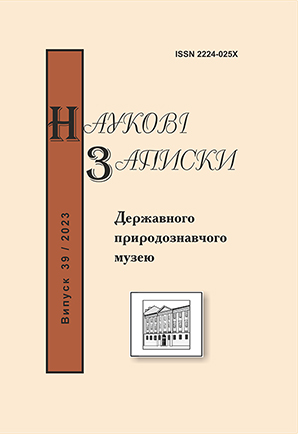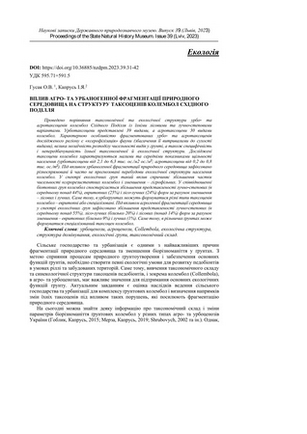Husak O.V. Kaprus I.Ya.
The influence of agro- and urbangenic fragmentation of the natural environment on the structure of Collembolan taxocenes of the Eastern Podillia // Proc. of the State Nat. Hist. Mus. - Lviv, 2023. - 39. - P. 31-42 DOI: https://doi.org/10.36885/nzdpm.2023.39.31-42 Key words: urbocenoses, agrocenoses, Collembola, ecological structure, dominance structure, ecological groups, taxonomic composition A comparative analysis of the taxonomic and ecological structure of Collembolan urbo- and agrotaxocenes of Eastern Podillia with their forest and meadow-steppe variants was carried out. Urbotaxocenes are represented by 39 species, and agrotaxocenes by 30 species of Collembola. A characteristic feature of the fragmented urbo- and agrotaxocenes of the studied region is the "xerophyllization" of the fauna (enrichment with drought-resistant species), the large mosaic distribution of the abundance of species in the soil, as well as the specificity and unpredictability of their taxonomic and ecological structure. The investigated collembolan taxocenes are characterized by low and medium population density (urbotaxocenes from 2.1 to 6.3 thousand individuals/m2 individuals/m2; agrotaxocenes from 0.2 to 0 .8 thousand inhabitants/m2). Under the influence of urban fragmentation of the natural environment, multidirectional and often unforeseeable restructuring of the ecological structure of the collembolan taxocenes has been recorded. In the spectrum of ecological groups, this influence causes an increase in the number of xeroresistant collembola and a decrease in hygrophilous ones. In the ratio of biotope groups of Collembola, there is an increase in the representation of meadow-steppe (on average more than 44%), eurytopic (25%) and forest-meadow (24%) forms due to a decrease in forest and meadow forms. That is why different types of collembolan taxocenes can form in urbo-soils - eurytopic or specialized. Under the influence of agrogenic fragmentation of the environment in the spectrum of ecological groups, an increase in the representation of meadow-steppe (on average more than 55%), forest-meadow (about 20%) and forest (over 14%) forms was recorded due to a decrease in eurytopic (about 9%) and grasslands (1%). That is why a specialized collembolan taxocene can form in agricultural soils.
The influence of agro- and urbangenic fragmentation of the natural environment on the structure of Collembolan taxocenes of the Eastern Podillia // Proc. of the State Nat. Hist. Mus. - Lviv, 2023. - 39. - P. 31-42 DOI: https://doi.org/10.36885/nzdpm.2023.39.31-42 Key words: urbocenoses, agrocenoses, Collembola, ecological structure, dominance structure, ecological groups, taxonomic composition A comparative analysis of the taxonomic and ecological structure of Collembolan urbo- and agrotaxocenes of Eastern Podillia with their forest and meadow-steppe variants was carried out. Urbotaxocenes are represented by 39 species, and agrotaxocenes by 30 species of Collembola. A characteristic feature of the fragmented urbo- and agrotaxocenes of the studied region is the "xerophyllization" of the fauna (enrichment with drought-resistant species), the large mosaic distribution of the abundance of species in the soil, as well as the specificity and unpredictability of their taxonomic and ecological structure. The investigated collembolan taxocenes are characterized by low and medium population density (urbotaxocenes from 2.1 to 6.3 thousand individuals/m2 individuals/m2; agrotaxocenes from 0.2 to 0 .8 thousand inhabitants/m2). Under the influence of urban fragmentation of the natural environment, multidirectional and often unforeseeable restructuring of the ecological structure of the collembolan taxocenes has been recorded. In the spectrum of ecological groups, this influence causes an increase in the number of xeroresistant collembola and a decrease in hygrophilous ones. In the ratio of biotope groups of Collembola, there is an increase in the representation of meadow-steppe (on average more than 44%), eurytopic (25%) and forest-meadow (24%) forms due to a decrease in forest and meadow forms. That is why different types of collembolan taxocenes can form in urbo-soils - eurytopic or specialized. Under the influence of agrogenic fragmentation of the environment in the spectrum of ecological groups, an increase in the representation of meadow-steppe (on average more than 55%), forest-meadow (about 20%) and forest (over 14%) forms was recorded due to a decrease in eurytopic (about 9%) and grasslands (1%). That is why a specialized collembolan taxocene can form in agricultural soils.
References
- Гоблик К.М., Капрусь І.Я. 2015. Урбаногенна трансформація угруповань колембол Закарпатської низовини. Природа Західного Полісся та прилеглих територій. Луцьк. № 12. С. 163–171.
- Гусак О., Капрусь І. 2023. Еколого-фауністична характеристика лучно-степових таксоценів колембол Східного Поділля. Вісник Львівського університету. Серія біологічна. Вип. 88. C. 69–79.
- Капрусь И.Я. 2003. Ногохвостки (Collembola) Волыно-Подолья, в Чернобай Ю. и др. Экология и фауна беспозвоночных западного Волыно-Подолья. Київ : Наук. думка. С. 100 –172.
- Капрусь І.Я. 2010. Таксономічна структура і типологія регіональних фаун ногохвісток (Collembola) Євразії. Наукові записки Державного природознавчого музею. Львів. Вип. 26. С. 39–50.
- Капрусь І.Я. 2013. Хорологія різноманіття колембол (філогенетичний, типологічний і фауністичний аспекти). Дисертація доктора наук, Інститут зоології НАН України. Київ. 497 с.
- Капрусь І.Я., Гоблик К.М. 2015. Екологічна та созологічна оцінка ґрунтів Закарпатської низовини за угрупованнями колембол. Наукові записки Державного природознавчого музею. Львів. Вип. 31. С. 45–58.
- Капрусь І.Я., Гусак О.В. 2021. Особливості таксономічної та екологічної структури лісових таксоценів колембол Східного Поділля. Наукові записки Державного природознавчого музею. Львів. Вип. 37. С. 75–86.
- Капрусь І.Я., Махлинець Т.М. 2015. Особливості фауни й населення колембол правобережного сектору лісостепової зони України. Наукові записки Державного природознавчого музею. Вип. 31. С. 59–72.
- Кузнецова Н.А. 2005. Организация сообществ почвообитающих коллембол. Москва : ГНО Прометей. 244 с.
- Мерза С.П., Капрусь І.Я. 2019. Фауна й населення колембол агроценозів Малого Полісся. Наукові записки Державного природознавчого музею. Львів. Вип. 35. С. 97–110.
- Стебаева С.К. 1970. Жизненные формы ногохвосток (Collembola). Зоол. журн. Т. 44 № 10. С. 1437–1454.
- Magurran A.E. 2004. Measuring Biological Diversity. Blackwell Publishing Ltd, UK. 256 pp.
- Shrubovych J. 2002. The fauna of springtails (Сollembola) in Lviv. Vestnik zoologii. Vol. 36 No 2. P. 63–67.
- Roithmeier O., Burkhardt U., Daghighi T., Filser J. 2018. Desoria trispinata (MacGillivray, 1896), a promising model Collembola species to study biological invasions in soil communities. Pedobiologia. Vol. 67. P. 45–56.
- Stöcker G., Bergmann A. 1977. Ein Modell der Dominanzstruktur und seine Anwedung. In Modellbildung, Modellrealisierung, Dominanzklassen. Archiv für Naturschutz und Landschaftsforschung. B. 17 No 1. S. 1–26.


